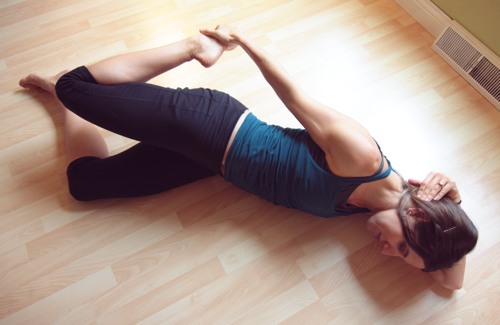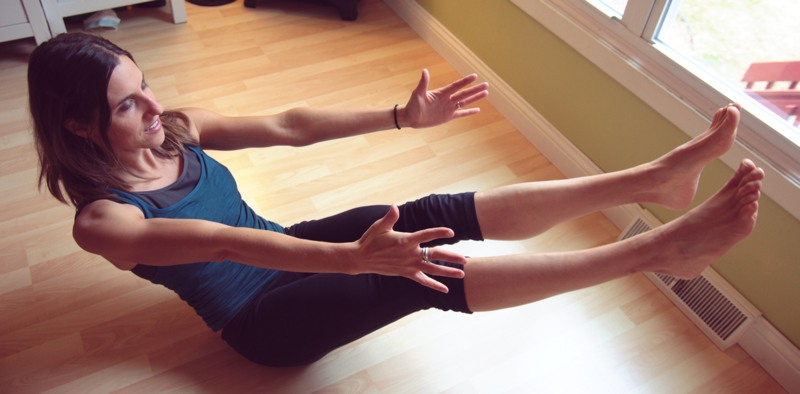Tight hip flexors? Change the way you do this exercise.
This post is for you, my running friends! And anyone else who has short, tight hip flexors…
The exercise above is called boat pose. Many people practice variations of it to strengthen the abdominal muscles. A common variation is double leg lowering, where the legs are lowered and raised. This pose can work to strengthen the abdominals, but when we feel this pose mainly in the muscles on the top of the thighs, the hip flexor muscles are doing the work.
Why might this be the case?
It is easiest for our bodies to contract muscles that are already short and tight. The hip flexors are used to lift the leg up, as in running or biking. The hip flexors are held in a shortened position when we sit for prolonged periods. It is common to have tight hip flexors because of the popularity of these activities.

In this image, the psoas major (one of the hip flexors) pulls the leg up.
When we have tight hip flexors, we should modify boat pose so that we are not reinforcing the dominance of the hip flexors over the abdominals.
How do we do that?
Step 1: Stretch the hip flexors
Begin by stretching the hip flexors. When the hip flexors are longer, they will not be able to shorten (contract) as easily. A good exercise for this is lying on your side and pulling the foot back toward your butt. Be careful not to let your back arch, or you will not feel a stretch. Hold this position as you breathe in and out 4-6 times on each side.

Another stretch that works for the hip flexors is the standing stretch from an earlier post.
Step 2: Prime the abdominals
The next step is priming the abdominals. By priming, I mean putting the muscle into a shortened position so that it can contract more easily.
Easiest method: Lie on your back with your thighs perpendicular to the floor. Put your hands on your thighs and pull your thighs toward your hands, resisting the motion with your hands as you breathe out, pulling your belly button toward the spine. This engages the transversus abdominus and external obliques. For more specifics, see the post on engaging the core.
Step 3: Find the right modification
The next step is finding a boat modification where you can actually feel the abdominals, and not the hip flexors, working the hardest. Begin with the easiest modification and stop when you feel too much tightness on the front of your thigh.
Here are the modifications I like:

In this variation, my feet are on the ground, and my abdominals do not need to work as hard to keep my pelvis neutral.

When I lift my feet, I must work harder with my abdominals because tight hip flexors want to do the work of holding my legs up.
Step 4: Advanced variations
- Gradually remove the hands from your thighs when you feel the abdominals “winning” over the hip flexors. This will happen as you improve your abdominal control.
- Begin to straighten one or both knees, maintaining activation in the abdominals by thinking about keeping the lower back flat
More detailed anatomy
For those curious about the anatomy here: tightening the (external oblique) abdominal muscles pulls the pelvis into a posterior tilt (flattened back) position. Tightening the hip flexors pulls the pelvis anteriorly and arches the back. Supporting the thighs with the hands holds the pelvis in neutral.
Ideally, we always want the pelvis in neutral, which is in between a posterior and an anterior tilt. Because of the prevalence of hip flexor tightness, learning to shut off the psoas and turn on the external obliques can be helpful.


Comments